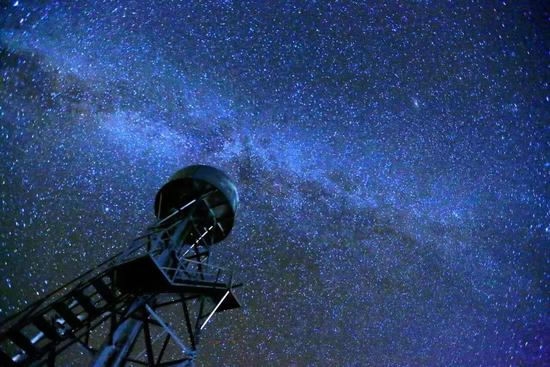
Tech & Sci
11:27, 22-Sep-2017
China builds world-class astronomical base in Tibet

Scientists are building a world-class observatory base at an altitude of 5,000 meters at Ngari, in China's Tibet Autonomous Region.
With its thin air and clear sky, they say Ngari Prefecture is an ideal place for astronomers to gaze into the remote universe.
Scientists have launched a project to detect primary gravitational waves. They also plan to conduct high-precision detection of cosmic rays and build China's largest optical telescope.

The Ngari Observatory under a starry sky /Xinhua Photo
The Ngari Observatory under a starry sky /Xinhua Photo
Xue Suijian, deputy director of the National Astronomical Observatories of China (NAOC), says astronomical observation requires clarity, transparency, tranquility, and aridity of the atmosphere. A suitable site for multiple wave-length observation is a rare resource.
It's widely believed that the world's best astronomical observatories are located on Mauna Kea Mountain, on Hawaii's Big Island, and in the desert in northern Chile. These two places, in the northern and southern hemispheres respectively, are home to more than 90 percent of the world's large astronomical facilities.
However, due to objections from native Hawaiians, the world's largest optical telescope, the Thirty-Meter Telescope (TMT), might be the last astronomical project to be built on Mauna Kea, says Xue.

The Ngari Observatory under a starry sky /Xinhua Photo
The Ngari Observatory under a starry sky /Xinhua Photo
Scientists are eager to find another good observatory base in the northern hemisphere.
Xue said NAOC began looking for a suitable site in western China in 2004, focusing on a ridge ranging from 5,000 meters to 6,200 meters above sea level in Ngari.
Now the Ngari Observatory is starting to take shape. Chinese universities and institutes, as well as research organizations from Japan and the United States, are joining NAOC with plans for projects there.
China's largest optical telescope, the 12-meter telescope, is expected to be built at the site. The project is included in China's large-scale sci-tech infrastructure plan for 2016 to 2020, says Xue.

The Ngari Observatory /Xinhua Photo
The Ngari Observatory /Xinhua Photo
Xue says NAOC will also cooperate with Tibet University and Ngari prefecture government to launch a project for the high-precision detection of cosmic rays above the 50 TeV energy region. Scientists from the University of Tokyo have pledged equipment worth tens of millions of yuan for the project.
Scientists are also building at Ngari the world's highest station to observe primary gravitational waves, dubbed "the first cry of the cosmos after the Big Bang."
Zhang Xinmin, lead scientist of the project with the Institute of High Energy Physics under the Chinese Academy of Sciences (CAS), says detection of primary gravitational waves is of great significance to study the origin and evolution of the universe.
Although the first detection of gravitational waves was announced in February 2016, no primary gravitational waves have been detected so far. But they remain a hot topic in international academic circles.

A stone inscribed with Chinese and Tibetan characters, meaning "Ngari Dark-night Park" /Xinhua Photo
A stone inscribed with Chinese and Tibetan characters, meaning "Ngari Dark-night Park" /Xinhua Photo
According to cosmic inflation theory, the universe expanded rapidly in a very short period after the Big Bang and caused ripples in space-time. The primary gravitational waves generated by cosmic inflation should have left traces in the cosmic microwave background (CMB).
In May 2014, Zhang Xinmin proposed a CMB detection experiment in Ngari, asserting that as primary gravitational waves were very weak, the detection site should have thin air, and the drier the better.
Ngari is one of the four places in the world regarded as the best sites for primary gravitational wave detection, alongside Antarctica, Chile's Atacama Desert and Greenland.
Zhang had considered China's Kunlun Station in Antarctica to conduct the experiment, but the infrastructure there was insufficient.
The primary gravitational wave detection experiment, a joint China-US project, was launched in late 2016.

The Ngari Observatory /Xinhua Photo
The Ngari Observatory /Xinhua Photo
The first stage of the project will see a telescope built at a site 5,250 meters above sea level to realize the first measurement of primary gravitational waves in the northern hemisphere. The telescope is expected to be installed at the end of 2019 and operational in 2020.
Scientists then plan to build a more sensitive telescope at a higher site to realize more accurate measurement of primary gravitational waves.
Scientists at the Institute of High Energy Physics of the CAS and Stanford University are cooperating to design the telescope, which will be 2.7 times more powerful than the BICEP 3 telescope in Antarctica, says Zhang.
Xue says China should utilize the unique geographical advantage of the "Roof of the World." The series of projects, scheduled to run until 2030, could help promote Tibet's social and economic development.
3339km
Source(s): Xinhua News Agency

SITEMAP
Copyright © 2018 CGTN. Beijing ICP prepared NO.16065310-3
Copyright © 2018 CGTN. Beijing ICP prepared NO.16065310-3